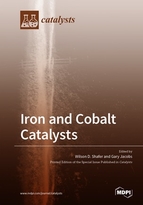Iron and Cobalt Catalysts
A special issue of Catalysts (ISSN 2073-4344). This special issue belongs to the section "Catalytic Materials".
Deadline for manuscript submissions: closed (31 August 2019) | Viewed by 104197
Special Issue Editors
Interests: clean energy; carbon dioxide utilization; heterogeneous catalysis processes such as Fischer-Tropsch synthesis, aromatization, steam reforming, and water–gas shift
Interests: heterogeneous catalysis; syngas conversion; hydrogen production
Special Issue Information
Dear Colleagues,
Since the turn of the last century—when the field of catalysis was born—iron and cobalt have been key players in numerous catalysis processes. These metals, because of their ability to activate CO and CH, remain a major economic impact worldwide. Several industrial processes and synthetic routes utilize these metals:
- Biomass-to-Liquids (BTL),
- Coal-to-Liquids (CTL),
- Natural Gas-to-Liquids (GTL),
- Water-Gas-Shift,
- Alcohol Synthesis,
- Alcohol Steam Reforming,
- Polymerization Processes,
- Cross-coupling Reactions,
- Photocatalyst activated reactions.
A vast number of materials are produced from these processes, including oil, lubricants, waxes, diesel and jet fuels, hydrogen (e.g., fuel cell applications), gasoline, rubbers, plastics, alcohols, pharmaceuticals, agrochemicals, feed-stock chemicals and other alternative materials. However, given the true complexities of the variables involved in these processes, many key mechanistic issues are still not fully defined or understood.
This Special Issue of Catalysis will be a collaborative effort to combine current catalysis research on these metals, from experimental and theoretical perspectives on both heterogeneous and homogeneous catalysts. We welcome contributions from the catalysis community on catalyst characterization, kinetics, reaction mechanism, reactor development, theoretical modeling, and surface science are all welcome.
Prof. Wilson D Shafer
Prof. Gary Jacobs
Guest Editors
Manuscript Submission Information
Manuscripts should be submitted online at www.mdpi.com by registering and logging in to this website. Once you are registered, click here to go to the submission form. Manuscripts can be submitted until the deadline. All submissions that pass pre-check are peer-reviewed. Accepted papers will be published continuously in the journal (as soon as accepted) and will be listed together on the special issue website. Research articles, review articles as well as short communications are invited. For planned papers, a title and short abstract (about 100 words) can be sent to the Editorial Office for announcement on this website.
Submitted manuscripts should not have been published previously, nor be under consideration for publication elsewhere (except conference proceedings papers). All manuscripts are thoroughly refereed through a single-blind peer-review process. A guide for authors and other relevant information for submission of manuscripts is available on the Instructions for Authors page. Catalysts is an international peer-reviewed open access monthly journal published by MDPI.
Please visit the Instructions for Authors page before submitting a manuscript. The Article Processing Charge (APC) for publication in this open access journal is 2700 CHF (Swiss Francs). Submitted papers should be well formatted and use good English. Authors may use MDPI's English editing service prior to publication or during author revisions.
Keywords
- Iron
- Cobalt
- Catalysis
- CO activation
- CH activation







